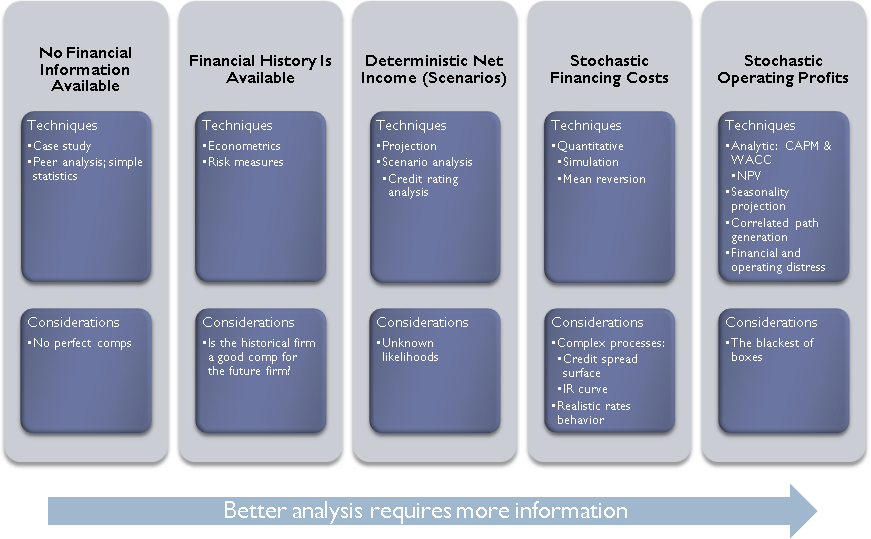Corporate Finance Analysis
Better analysis requires more information. In this recipe you will learn
- What defines quantitative corporate finance analysis
- The spectrum of analysis types
- The data (company fundamental or market) required for each type
- Trade-offs
The Availability of Data
Information is difficult and costly to acquire. This issue is at the forefront of quantitative analysis, which elevates the reliance on data in decision making. The following diagram lays out, left to right, the use of increasing amounts of information:  As we move to the right (make use of increasing amounts of information), we find the following:
As we move to the right (make use of increasing amounts of information), we find the following:
- The quality of advice improves: we are modeling a situation closer to that of our client, and we are controlling for more variables that may influence our advice.
- The speed of analysis falls: it takes longer to acquire and scrub the information; longer to analyze it; longer to detect and correct errors in the client model; and so on.
- The sophistication of advice increases, which may mean the client becomes increasingly skeptical of the advice.
Let’s see how these trade-offs occur as walk through the roadmap from left to right, one column at a time. For illustration, we’ll use debt capacity as our focus.
No Financial Information Is Available
A remarkable amount of advice is given without any meaningful information about the company at all. If all we know about a company is its sector (industry), one standard approach is to analyze other firms in the same sector, treating them as exemplars. This is called “peer analysis” or “case study.”
But no two firms are identical, so the recommendation for the client firm may need to be adjusted. For example, if the client is much larger than the peer, perhaps the client can support more debt. But exactly how much more isn’t prescribed. Regression analysis can provide insight, but it can also mislead.
Financial History Is Available
If we have a firm’s historical financials, we can see how it performed in various market environments (i.e. through the business cycle). For example, a history of a firm’s interest coverage ratio or cash/sales balances may enlighten. The quality of advice improves when you narrow focus to the client firm, but we still have a problem with comparability: advice based on a firm’s history is only relevant if the firm and its environment continue into the future: Is the firm now bigger? Has its competitive landscape changed? What will the overall economy do?
Deterministic Net Income
Standard financial modeling, which projects a firm’s performance into the future, may rely on scenario analysis. Here we turn the foundation of advice from purely retrospective to including a prospective element.
Typically the analyst defines base-case and downside-case scenarios, where the downside scenario is agreed to have a small but meaningful likelihood of occurring. Herein lies the chief shortcoming of this type of stress testing: estimating that likelihood. If the estimated likelihood is lower than the actual likelihood, the firm may be positioned too aggressively.
Scenarios necessarily include — whether explicitly or not — expectations of all relevant operating and environmental factors. One simplistic approach to scenario generation could be to project sales at their 10th percentile (historically observed) growth rate. This however ignores a host of important factors:
- changes in other variables (interest rates, FX rates, commodity prices)
- correlation with other variables (e.g., are margin swings independent of sales changes?)
- general direction of the economy, competitive pressures, and so on
Stochastic (Randomized) Financing Costs
Improving our estimation of scenario likelihoods requires more thought about the range of values for all important factors. Generating realistic values for these factors requires calibrating our generation process to defensible predictions. Several important market rates (exchange rates, credit spreads, interest rates, commodity prices) have widely observable forward curves and implied volatility rates, which gives us a stake in the ground for calibrating our projections. Randomizing these projections allows us to create Monte Carlo simulations of the firm’s performance under a broad population of potential funding-cost scenarios.
Stochastic Operating Profits
For most firms, market rates aren’t the greatest risk influencing firm profitability; rather it’s uncertainty in operating asset performance: Sales, COGS, and so on. Devising defensible projections of these risk factors is complicated by the absence of active markets in a particular firm’s forward revenue or operating profits. As such we need additional techniques for projecting these risks accurately. The payoff for this additional work is a defensible value for the likelihood of various downside scenarios occurring.
Recipe
- Identify the question to be answered, and the deadline for an answer.
- Determine the information required to execute the desired analysis.
- Discuss the analysis techniques with the client: their assumptions, data needs, and underlying mathematical approach.
- Consider tradeoffs, including the impact of information acquisition effort, analysis sophistication, precision of the answer required.
- Conduct the analysis.
- Document the assumptions, approach, findings, and recommendations.
Leave a Reply